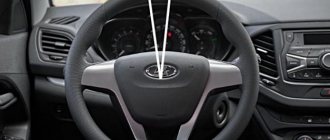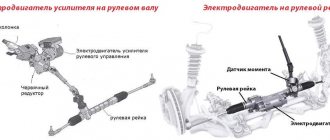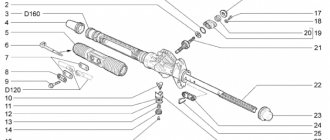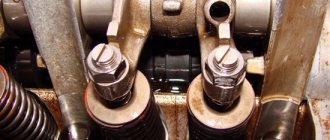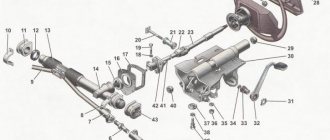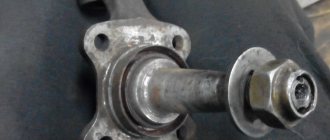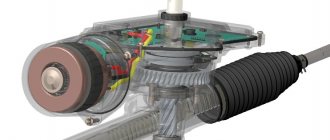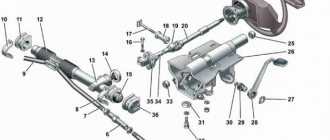The pleasure of driving a particular car is difficult to describe in words, but you can try to explain it by its design features. If we talk about the information content of the steering, then in addition to the architecture of the car’s chassis as a whole, the type of its amplifier plays an important role.
An uninformative or “wobbly” steering wheel, its poor self-return, weak feedback from the road, and so on - all these points depend primarily on the design of the steering system. Friction losses and parasitic moment of inertia play a fundamental role here.
Power steering hydraulic system
It’s worth starting with this option, because it was the first to appear on cars and has still not lost its relevance.
Principle of operation
: Very simple, here the main working fluid is a special liquid, which is often poured into. The steering rack itself is a hollow cylinder into which a piston goes, attached to the steering shaft (to exaggerate it, it looks very much like a pharmaceutical syringe). A special pump pumps oil pressure in one direction or the other, and this piston begins to deviate in one direction or the other, accordingly helping you turn the steering wheel. There is approximately 0.5 - 1 liter of oil in the system, it is pumped by a pump that is driven by the engine crankshaft, that is, they are connected by a belt drive. Of course, the system contains metal and rubber tubes through which the working fluid actually pumps.
A few words about EGUR
. That's why electric power steering is now starting to appear. What does it mean? The differences are few, but they are significant - here, instead of a belt pump, an electric motor is used, that is, electricity is simply supplied and it pumps oil in the system. Thus, taking much less power and saving up to 0.5 - 0.7 liters per 100 km. Well, now it’s time to think about the pros and cons of this device
Pros of GUR
- Controllability. The driver has good feedback from the road; in terms of response accuracy and response, power steering comes first
- Great effort. Such amplifiers are installed on many HEAVY trucks; all electrical systems are not yet fully adapted
- Comfortable handling at both low and high speeds
- Now there are new generation devices with electric pumps that do not use a belt drive and save fuel
- There are no complex electronic sensors, we can call this system analog (except for power steering)
- Reliability is at a fairly high level, if you monitor it and change it on time, it can last a very long time
In general, there are not many complaints about this system; it still works stably, accurately and, importantly, can “turn” heavy truck racks. However, there are also a lot of negative aspects
Cons of GUR
- Takes up quite a lot of space under the hood (pipes, pump, rack itself) all this is quite cumbersome
- It has a special oil that needs to be changed after a certain number of kilometers, otherwise it may break down. Because oil seals can wear out faster
If the model is old (belt), it increases fuel consumption by up to 10% (if compared with the opponent). Because it additionally creates a load on the engine (pressure is built up thanks to a belt drive that comes from the crankshaft, respectively, part of the engine energy is spent on the hydraulic booster). Even at idle
- At low temperatures, you need to use it more carefully, it is advisable to warm it up
- If there is a leak or oil has leaked out, then you cannot operate the car! Or very limited mileage. Otherwise, the pump itself that pumps the oil may break.
- Repairs are sometimes very expensive. Although almost all service stations do this, there is nothing particularly complicated here
As you can see, the disadvantages of this system are also significant, especially power take-off and fuel consumption. After all, if you have a small-volume engine, it’s already “dead,” and then it also takes away the hydraulic booster.
Operating principle of power steering (power steering)
Power steering (power steering) involves the use of liquid (oil) as an object that creates pressure on the walls of the piston. When the engine starts, the pump turns on. By means of a belt drive, the torque from the engine is transmitted to the impeller of the pump, which begins to pump oil from the tank (oil reservoir) and drives it through the system (closed system: tank, pump, distributor, hydraulic cylinder, tank), creating excess pressure in it. At the moment when the driver turns the steering wheel, the distributor directs working fluid under pressure into one or another chamber of the hydraulic cylinder, its piston moves and pushes the steering rods - steering becomes easier and the wheels turn. The distributor re-engages when the driver turns the steering wheel in the opposite direction. Thanks to this device, fluid is supplied to another chamber of the hydraulic cylinder and the piston supplements the force created on the steering rods.
The hydraulic steering mechanism is connected through a gear transmission to the steering rack and transforms the torque into translational motion; in the event of a failure of the hydraulic booster (power steering), it independently, without the help of a hydraulic cylinder, transmits it to the steering rods. The driver will definitely feel the moment when the required force on the steering wheel has changed; the main thing is to react in time. Therefore, one of the features of power steering (power steering) is constant monitoring and timely maintenance of the mechanism and its components.
Advantages:
- high power potential (an enviable indicator for trucks and SUVs);
- relatively low cost production and maintenance.
Flaws:
- constant operation of the pump (when the car moves in a straight line, the pump works to transfer oil in a closed circle, since excess pressure can be required at any time);
- takes away engine power, even if it is intended to move in a straight line;
- subject to operational interruptions due to temperature changes;
- probability of failure when working in critical positions;
- has not proven itself at high speeds;
- The fluid has to be changed from time to time.
Possible malfunctions:
- pump wear (repair and replacement of parts are allowed);
- faulty power steering gearbox;
- distributor malfunction (valve malfunction and spool wear may occur);
- wear of shafts and bearings;
- the system is not tight (hoses, seals) or the liquid level is low, the system is airy.
What is the difference between power steering and electric power steering and which is better?
Now let’s compare these types of amplifiers with each other and try to determine which is better: hydraulics or electricity?
Let's start with the design features. The hydraulic booster is quite simple in structure, it is not afraid of malfunctions in the ECU. However, its anthers and hoses, as well as all kinds of seals, connections and other elements wear out relatively quickly. In addition, you need to monitor the fluid level in the power steering system. The electric amplifier is distinguished by greater durability and independence from consumables. Failures in the car’s electronic system can disrupt its operation, but they happen quite rarely. And if such a problem manifests itself, then problems with the EUR will probably be the least of the problems. Both types of mechanisms have an emergency mode of use.
Let's move on to ease of use. As practice shows, hydraulic boosters of even the simplest designs are more informative than electronic systems. They provide better connection with the road surface and make it possible to experience the maximum capabilities of the car when taking sharp turns. The EUR is theoretically also capable of this, but for this it must be carefully calibrated, which is done only on premium cars. In general, the hydraulic booster provides a highly informative and natural driving experience - however, it requires more physical strength than the electrical system.
Next, we will consider amplifiers from the point of view of efficiency and reliability. During operation, power steering consumes the power of the car's engine, which is why its appetite increases and its dynamic characteristics deteriorate. In addition, it is sensitive to high loads: it is not recommended to hold the steering wheel in extreme positions for more than 15 seconds, otherwise the pump may fail. The electric booster is driven by its own motor. Under increased loads, it can also overheat, but the automation in this case will reduce its performance or turn it off until the temperature drops.
The scope of application of the power steering is higher; it can be used both on a city minicar and on a multi-ton truck. The EUR is much weaker and therefore suitable only for passenger cars (and even then not for all).
Therefore, it is impossible to give a clear answer to the question of which is better power steering or electric steering. The latter was developed as a replacement for the hydraulic system, devoid of its inherent disadvantages, so for a number of factors it is definitely better. At the same time, power steering has a significantly wider scope of application and at the same time a lower price. Therefore, preference should be given to one option or another solely taking into account personal preferences and the characteristics of the desired car.
What is power steering in a car (hydraulic power steering)
This device works like a pump. The steering mechanism is influenced by fluid (oil) pressure.
When the engine is turned on, the rotating drive belt drives the hydraulic pump. A constant supply of oil from the tank to the system is maintained.
Why it’s scary and how to repair engine water hammer.
Watch how to polish a windshield yourself.
What to do if the beating of the brake pedal bothers you?
When the driver turns the steering wheel, a special mechanism (spool valve) moves in response to this rotation and closes the oil drain channel back into the tank. The liquid flows through the distributor (valve) into the power hydraulic cylinder.
It converts fluid pressure into piston pressure, which produces a force on the steering. When you complete a turn and move straight ahead, all channels open, the oil goes back into the tank and continues to circulate idle through the system through connecting hoses.
Electric power steering operating principle
The working fluid fills the reservoir and then goes to the power steering pump through the connecting hose. When you turn the steering wheel, the control unit supplies power to the electric motor, which turns on and begins to rotate the power steering pump shaft at a frequency depending on the vehicle speed and the force applied to the steering wheel. Power is also supplied to the corresponding solenoid valve, depending on the direction of rotation. The pump creates fluid pressure and transfers it through the corresponding valve to the hydraulic cylinder. The hydraulic cylinder, using the energy of the working fluid, generates a force proportional to the pressure of the fluid, which moves the piston and rod, then they turn the wheels in the desired way using a system of levers.
Design and principle of operation of power steering
Hydraulic power steering is one of the earliest forms of technology. This system consists of various components and parts such as the pump, pulley, drive belt, hoses, and power steering fluid. They all work together to create the hydraulic force that turns the steering wheel so easily. But let's look at how this pressure is created.
Your car's engine contains a vane pump that creates hydraulic pressure at the right time. Whenever you turn the steering wheel, the pump will generate more hydraulic pressure to increase the force when you turn the steering wheel. The pressure increases because additional hydraulic fluid enters the hydraulic cylinder from the valves. Once this happens, the mechanism receives pressure from the cylinder and causes the wheels to move along with the steering mechanism.
Benefits of driving with power steering
- the amplifier takes the lion's share of the load onto itself;
- there is no need for a large number of turns of the steering wheel, it does not break out of your hands;
- the feeling of road unevenness is softened;
- the machine is easier to control, maneuverability increases; difficult turns can be made without effort;
- taxiing at low speeds becomes more convenient;
- the trajectory of movement is stabilized;
- if the front tire is punctured, it is easier to hold the car;
- the driver is less stressed and does not get tired;
- This is especially true if the driver is a woman;
- The wear resistance of the steering mechanism increases and its service life is extended.
All this ensures the most safe and comfortable driving (provided the car is in good technical condition).
A potential danger arises only in an emergency situation - a sudden failure (breakdown) of the power steering system when turning while driving. In this case, the reaction, knowledge and experience of the driver become crucial. Problems can be signaled by extraneous noises, vibrations, sharp jolts, turning the steering wheel, turning it difficult or too easy.
According to statistics, a quarter of Russian drivers prefer power steering, and half prefer electric power steering (and the indicators are biased in favor of electric power steering). The advantages of each of these mechanisms are determined by their design features.
Modern cars use electric power steering, hydraulic power steering and electric power steering.
What is power steering (power steering)?
The hydraulic booster appeared first and significantly simplified driving, while its main task was not only to remove the power load from the driver’s hands, one of the tasks that the designers set for themselves was safety. After damaging the front wheel at speed with power steering, the driver did not lose control of the car, and also felt less vibrations that came from the wheels while driving over uneven surfaces.
How does power steering work?
The power steering is a set of components, including: a system of high and low pressure oil lines, an oil pump with the help of which the power steering fluid circulates into the reservoir in which the power steering fluid is located, as well as the steering rack and tips. When you turn the steering wheel, a number of events occur in the power steering system that you are not even aware of. You, the driver, turn the steering wheel and set the direction, after which a special fluid (synthetic or semi-synthetic oil, almost the same as in an automatic transmission) is pumped under high pressure through a distributor. Thereby generating a force that, acting on the hydraulic cylinder and piston, shifts the steering rack mechanisms in the direction you need. After this, the power steering fluid is returned through the return flow system to the power steering reservoir.
Pros and cons of EUR
The advantages of EUR are the following nuances:
- it does not require the power of a car engine to operate;
- fuel is saved to a certain extent;
- the electronic mechanism is quite compact;
- the system does not use liquids, so operation is simplified;
- the EUR design does not contain damage-sensitive hoses, boots, etc.;
- The steering system, equipped with an electric booster, always works clearly, without losing the sharpness of its response.
The disadvantages of electric power steering include the following:
- high price - EUR is significantly more expensive than power steering;
- the complexity and high cost of repairs, although the service life of such units is quite large;
- low power, which is why heavy jeeps, trucks and other heavy vehicles are not equipped with electric boosters.
Efficiency and reliability
Using power steering forces the car to lose some of its power - it goes to drive the pump, which can have quite large needs. Therefore, the use of power steering inevitably leads to a deterioration in dynamic parameters and a significant increase in fuel consumption with other comparable parameters. Moreover, even with constant movement in a straight line, the situation does not improve at all - the pump works constantly, moving oil through the high and low pressure pipes.
Every motorist should know that the hydraulic booster cannot withstand operation in extreme conditions for a long time - if the steering wheel is held in the extreme position for 10-15 seconds, the pump will overheat, as a result of which the unit will completely shut down. To restart it, you need to turn off the car, wait a few minutes and start it again, carefully moving the steering wheel from the extreme position to the zero point.
Electric boosters are considered more economical - they do not take engine power directly, but only create additional load on the generator. In addition, the electric booster only works when the wheels are turning, and when moving along a straight path, the motor remains completely switched off - it does not worsen the dynamic characteristics of the car and does not create additional ones. Also, when turning the steering wheel to its extreme position, heating will occur only when the steering wheel is rotated very quickly in different directions, which can only be done on purpose.
However, turning off the electric boosters cannot be called a rarity - this mainly happens when driving off-road or on roads covered with viscous, loose snow. After some time, the unit will give an alarm, after which its performance will be limited and the driver will see a warning, and if driving continues under similar conditions, the amplifier will turn off until the motor has completely cooled.
Basic information about power steering
So, what is hydraulic power steering in a car, what is its operating principle, what pressure should be in the system? To begin with, we suggest finding out what power steering is needed for and what devices it consists of.
Functions
As we have already reported, the main function of the hydraulic booster is to provide easier vehicle control. Thanks to the amplifier, the process of turning the steering wheel will be easier when performing maneuvers. In addition, this device makes it possible to protect yourself in case of unexpected situations on the road. In particular, in cars with power steering, the steering wheel is not as susceptible to vibrations as in a car without power steering, this becomes especially clear when the car falls into a hole or hits a bump.
If a vehicle tire is accidentally punctured while driving, thanks to the booster this will not affect traffic safety. This is because the unit automatically locks the steering wheel in a straight position.
Power steering pump diagram
Diagram of power steering and elements
If everything is clear with the main functions of the hydraulic booster, now we suggest you understand the circuit diagram and structure of the system.
So, what elements does the hydraulic booster system consist of:
- The pumping device is considered one of the main components of this system. This unit allows you to provide the system with the necessary pressure due to the circulation of working fluid through its lines. Virtually all modern vehicles typically use plastic pumping devices. Their advantage is that they provide higher efficiency and have a longer service life than traditional pumps. Taking into account the design features of the car, the pumping mechanism can be located in different installation locations, but usually it is located on the engine.
- Distribution unit. This device performs the option of directing and distributing the working fluid - oil - into certain cavities of the cylinder. Machines from different manufacturers may use several types of distributors - they can be either axial or rotary. If the movement of the spool through the amplifier system is translational, then this indicates that the distributor is axial, but if the spool rotates, then the distribution unit is rotary. This system device allows the mechanism to be located either on the shaft or under the steering gear. The switchgear itself is a unit that is sensitive to contamination of the oil used.
- The next component of the system is the hydraulic cylinder. The main purpose of this device is to actuate the piston and rod by applying oil to these components. If the pressure level in the system is sufficient, the wheels of the vehicle will turn under the influence of levers. The cylinder itself can be located on the steering rack or between the car body and the drive.
- Also, any power steering system consists of connecting lines and hoses, without which its full operation would be impossible. The primary purpose of the lines is to ensure the passage of working fluid from one system node to another. Between themselves, the lines are divided into high or low pressure pipes. The former are used to supply consumables between the pumping device, distribution unit and cylinders. The second ones are designed for circulating fluid return from the expansion tank to the pumping device and vice versa.
- As stated earlier, the functioning of a hydraulic system is impossible without the use of a working fluid, that is, oil. This substance is intended to provide force to the cylinder from the pump. The oil also allows for high-quality lubrication of all system elements.
- The drive belt, thanks to which the belt drive is carried out.
- The expansion tank contains the working fluid used for circulation. The tank has a filter element that effectively cleans the working fluid as it circulates. Also in the tank there may be a special dipstick with marks, thanks to which you can check the oil level (video published by user Sanya Mayevsky).
Operating principle
How does hydraulic booster work? Previously, we reported that, depending on the design features of the system, two types of spools can be used in the power steering, but despite this, the principle of operation in both cases will be almost the same. When the steering wheel is in the central position, the wheel is fixed using centering springs. In this steering wheel position, oil moves throughout the entire system without problems, since the pumping device operates in a more powerful mode. This is because at this stage the primary function is to move oil through the system, and the pumping device always functions, regardless of turning the steering wheel.
If the driver turns the steering wheel of the car, this causes the spool to move. When the spool moves, it will block the drain lines, and consumables will begin to flow into one of the cylinders. In this case, the oil itself will act on the piston and rod, which will contribute to the rotation of the wheels, as well as the switchgear housing in the direction of movement of the spool. The distributor body will catch up with the spool when the latter stops moving, this will indicate that the driver has performed a maneuver involving turning the steering wheel. Ultimately, the spool will return to its original state, which will lead to the opening of the pipe to drain the working fluid.
Advantages of electric power steering
- Ease of steering with electric steering (“one finger”). Excellent maneuverability when parking, quick adaptation to changes in speed.
- Settings of power steering parameters for various operating modes. (Crosswind stabilization, car parking)
- Width of temperature range for EUR. The fluid in the power steering can freeze and boil under the influence of temperatures and overloads.
- Simplicity of design and maintenance of the EUR. You just need to monitor the condition of the bearings. Power steering maintenance is more labor-intensive. Regular inspection is required for integrity, monitoring the tightness of hydraulic tubes, checking the tension of the drive belt, and the oil level. There are rules for changing the oil and filter.
- Compact dimensions of the EUR.
- Economical efficiency of electric power steering (less fuel consumption, higher efficiency).
- Operation of the machine after disconnecting the faulty power steering. This is undesirable for power steering (the steering is destroyed; other breakdowns may occur).
- The ability to hold the steering wheel in the extreme position for a long time with ESD. On cars with power steering, a delay of more than 5 seconds threatens serious damage.
- Environmental friendliness of the EUR. Cars with power steering produce more harmful emissions; power steering units that have expired are more difficult to dispose of.
- Serious prospects for progress of ESD.
What is an electric power steering wheel (EPS) and how does it work?
Many years after the appearance and successful use of power steering, the EPS appeared - Electric Power Steering. The task of the EUR is the same as that of the power steering - to facilitate steering and steering. Unlike a hydraulic booster, the EUR does not use liquid in its design; instead, an electric motor is used, which creates the necessary force. Among other differences, the EUR is distinguished by a large number of electronics, various sensors, as well as an entire electronic control unit (ECU). The installation principle of the EUR also differs from its hydraulic counterpart. The electric analogue is located directly on the steering rack or steering column itself, and rotation and transmission of torque occurs using a torsion shaft, which is built into the steering system.
The hydraulic booster creates force using a pump and fluid, which creates pressure under which the steering mechanisms are shifted and the wheels are turned directly; the electric booster performs the same action, only it uses an electric motor and current for this. When the electric power steering is turned, the ESD torque sensor detects this and reports this to the ECU. Then the electronic unit analyzes the data and, guided by certain algorithms, determines the amount of current required for the electric motor to turn the steering wheel. A characteristic difference for the electric power steering is the ability to increase/decrease the force depending on the speed of the vehicle. As you know, at speed, turning the steering wheel is much easier and there is practically no need for a booster, but a hydraulic booster, unlike an electric booster, is not able to take into account the speed of movement and the angle of rotation, due to which at speed the steering wheel of a car with power steering becomes “wobbly” and uninformative. The ESD takes into account the speed of the car and reduces the gain, as a result the steering becomes sharper, and the driver has better control of his car during maneuvers.
Phew... We seem to have figured it out, now let's move on directly to comparing the pros and cons of each of these devices.
"Pros" of hydraulic booster
Power steering is a relatively inexpensive system, installed mainly on large cars or budget cars. The production of a power steering system is less expensive, due to which the manufacturer reduces the cost of its cars.
Power reserve. The hydraulic booster is more powerful, so they are equipped with SUVs and minibuses on which the use of electric power steering is impossible.
"Disadvantages" of the hydraulic booster
- It is necessary to constantly monitor the condition and level of fluid in the power steering. In addition, it must be changed in accordance with the requirements of the car manufacturer.
- Certain operating rules must be followed. For example, it is highly not recommended to hold the steering wheel in the extreme position for a long time, as this can lead to overheating of the power steering fluid or damage the power steering system.
- The hydraulic booster requires constant monitoring by the owner. You should regularly check the condition of drive belts, hoses, and the power steering pump for cracks, leaks, etc.
- The operation of the hydraulic booster directly depends on the operation of the engine. The power steering oil pump drive is connected to the motor, belt or chain, so if the motor does not work, it will be difficult to turn the wheels. In addition, when you are driving along a straight road at high speed, and there is no need for power steering, engine power is wasted, since the pump is still running and creates a certain load on the engine.
- The power steering will not allow you to adjust the force depending on the speed, steering wheel position or driving mode (“SPORT”, “NORMAL”, etc.).
- “Weakness” and lack of information from the steering wheel at high speed. As I already said, at speed the hydraulic booster “kills” sensitivity and it is difficult for the driver to perform the maneuver.
"Pros" of an electric amplifier
- Quite a simple and uncluttered design. This saves space under the hood.
- There is no pump or any hoses. This simplifies and reduces the cost of operation. There is no need to monitor the level or condition of the fluid in the reservoir or monitor the condition of belts and hoses.
- Compact sizes. Compactness allows you to place the EUR in the car interior, which significantly affects the “life” of this device.
- The electric booster saves fuel. Due to the fact that the EUR controls the control unit, the ECU practically does not use the electric booster while driving, thereby reducing the load on the engine, resulting in fuel savings.
- Possibility to customize the amplifier to suit your needs. The EUR can be very finely tuned, both the gain itself and the gain at certain speeds and operating modes.
- The steering wheel with ESD always remains “sharp”. This quality is very important for racers who value the informativeness of the steering wheel and the controllability of the car above all else.
"Disadvantages" of an electric amplifier
Despite its apparent perfection, the EUR has drawbacks.
- Price. Perhaps the most important and biggest disadvantage of an electric amplifier is its cost.
- Expensive repairs. Electric amplifiers are considered quite durable devices, but they are also susceptible to breakdowns, and if they do break down, they are difficult and expensive to repair. In some cases, it is necessary to change the entire mechanism assembly.
- Small power reserve. This drawback is the reason why SUVs, buses, pickups and trucks are not equipped with electric power steering.
It is these, at first glance, insignificant shortcomings that play in favor of the power steering and allow it to successfully coexist with the more profitable and in any way perfect power steering. Although, who knows!? Progress does not stand still and perhaps today someone is inventing or designing the newest and most advanced electric amplifier, which will forever displace the good old power steering from the automotive industry...
That's all I wanted to say. Now you know what power steering is and how it differs from electric power steering, as well as what differences there are between hydraulic and electric power steering. Thank you for your attention and for reading to the end. Peace to all and see you again on .
Pros and cons of power steering
The undoubted advantages of hydraulic boosters include the following:
- adaptability to high loads, which allows the use of power steering on heavy vehicles, including trucks;
- relative cheapness, which also affects the overall cost of the car;
- ease of machine control over a wide speed range;
- relative ease of maintenance and availability of repairs;
Power steering also has its disadvantages:
- engine power is used to operate the pump;
- the seals are easily damaged, as a result of which the system begins to leak;
- the efficiency of the hydraulic booster directly depends on the level of fluid in its reservoir;
- the fluid needs to be changed periodically;
- Power steering does not make it possible to individually adjust the performance characteristics of the steering system.
steering
When choosing the type of power steering, it is better to focus specifically on driving sensations.
Hydraulic and electrical systems have serious design differences and their own strengths and weaknesses. When choosing the type of power steering, it is better to focus specifically on driving sensations. Hydraulic and electrical systems have serious design differences and their own strengths and weaknesses.
Electric power steering or EPS
EPS is an electric power steering in which the force necessary to turn the wheels is created by an electric motor. A peculiarity of systems of this type is that they are mounted directly on the steering rack or column. For comparison: power steering is often installed as a separate system.
The main structural elements of the EUR are:
- electric motor;
- torsion bar;
- steering shaft;
- gearbox;
- steering position and angle sensor;
- torque sensor;
- Control block;
- toothed gears.
When the driver turns the steering wheel, the torsion bar twists. The torque created in this case is recorded by a corresponding sensor, in which the received information is interpreted into a signal supplied to the electronic control unit. Here, this data is analyzed and compared with information transmitted from other sensors, including the speedometer, tachometer, etc. Based on the results of the analysis, the ECU determines the force required to turn the steering wheel and sends a command to the electric motor. As it rotates, it transmits its rotation to the steering shaft or directly to the steering rack.
EUR
EUR with a worm drive built into the steering rack is easy to distinguish by appearance.
The electric motor is attached to its body next to the input shaft. EUR with a worm drive built into the steering rack is easy to distinguish by appearance. The electric motor is attached to its body next to the input shaft.
This view reveals a group of full electrical rails with built-in amplifier elements. In fact, such an electric power steering system has the same negative features when driving as in the previous example. The magnitude of parasitic friction losses and moments of inertia are similar.
During operation, the severity of malfunctions and the cost of repairs increases due to the fact that all elements of the amplifier are built into the rail.
Comparative characteristics
Disadvantages of electric power steering and advantages of power steering:
- There is sensitivity of the EUR to bad (sloppy, bumpy) roads and moisture (in particular, in bad weather - when there is snow, rain, puddles). In such cases, there is a danger of overheating and shutdown, as well as burnout.
- The power steering better smooths out shocks when the road is uneven and when hitting a curb.
- The EUR does not provide an immediate response if the wheels quickly turn in the other direction. And if you twist the steering wheel sharply, the system may turn off altogether.
- There are more possibilities for self-repair for power steering.
- In the case of electric power steering, the possibility of electronic failure cannot be ruled out (however, this mainly occurs in old and cheap models; another reason is non-compliance with operating rules).
- Production of power steering is less expensive; their price is lower than that of the EUR.
- The EUR is limited for installation on heavy trucks and SUVs (due to lack of power).
EUR electric power steering
It was created as a more advanced and simpler system (and is still being improved). It has a lot of varieties, at least read it.
Principle of operation
: Again, in a nutshell - everything is simply taken by an electric motor, connected to a shaft (on which there are special grooves, or a screw, or just splines) and this electric motor pushes this shaft to the right or left.
The only difference between electric amplifiers is that the electric motor can be attached to different parts of the steering mechanism:
- On the steering column
- On the rack shaft itself (I use a spline connection)
- Parallel to the steering column shaft (twin shaft systems)
- Using a ball nut
Ask why there are so many different mechanisms - it’s all because you haven’t yet achieved the normal effort and accuracy of “steering” like your opponent. Although the last type with a ball nut came very close to this.
Of course, the EURA has no liquid, no hoses and tubes, no pump - it is very compact, which often allows it to be mounted even on the steering column.
However, the negative side here is the presence of various sensors and other electronics, but everything is in order
Positive aspects of the electric booster
- The driver has sufficient effort and contact with the road
- Has two positions. City and highway. In city mode, the steering wheel is lighter, which contributes to comfortable driving. In the “road” mode, it turns off already at 40–60 km/h, which was done on purpose; at high speeds, an amplifier is not needed. Therefore the feedback is increased.
- Fuel economy. There is no additional load on the engine because it has no belt drives and is powered by electricity from a generator (battery). If the car is stationary and the steering wheel does not turn, it does not work. Activated only when turning. Allows you to save up to 10% fuel
- It takes up little space under the hood and in the cabin. Since it is technically simpler (and more compact) than power steering
- It has no liquid and, accordingly, is practically maintenance-free
- Has a wide temperature range of use. For example, in winter there is no need to heat it. Even a few seconds
- If it breaks, you can move freely, but the steering wheel will become heavier, at least you will always get to the service station
- Many electronic autopilot (autoparking) systems work only with electric power steering
- AT THE MOMENT - RELIABLE, not inferior in quality to the hydraulic booster
As you can see, there are really a lot of positive aspects, some of them don’t even know that they have an electric booster until it reaches 150 – 200,000 km, because there are simply no cans or other parts under the hood. I like that lately it has been tuned quite precisely, that is, it is beginning to be similar in “steering” accuracy to its opponent. However, it is still far from it, yet there are also a lot of disadvantages here
Negative points of EURA
Repairs are expensive and difficult to diagnose. Ordinary service stations often simply do not know what is broken, there are simply oxides on the contacts and such an amplifier is already faulty. You need special diagnostic tools to read errors. Also, the blocks here are often not repaired, but replaced as an assembly. If the engine is damaged, it is often cast with either a steering rack or a column; they are replaced together. AND THIS IS EXPENSIVE!
- If moisture gets under the protective covers, it may malfunction.
- Since it uses electricity, it requires the installation of a more powerful generator and complex wiring
- The first models sometimes “glitched”, turned in the wrong direction, and did not work clearly. True, this only happened on our VAZs
What is the difference between hydraulic and electric power steering?
What is the difference between an electric booster and a hydraulic one? What is better, hydraulic or electric booster? To understand what is really better - power steering or electric power steering, you need to familiarize yourself with the concept of the electrical system and the disadvantages of both components (the video was published by Sargis Muradyan).
What is EUR?
An electric amplifier is a system in which basic functions are performed through the use of electric current. Electric amplifiers began to appear later than hydraulic ones, so this unit is considered more modernized and more advanced. The key advantage of the ESD is considered to be improved communication between the driver and the vehicle. It should also be noted that the electric amplifier can operate in two modes - urban and suburban.
When operating in city mode, the amplifier allows the driver to control the car during maneuvers, that is, everything that the power steering offers. In suburban operating mode (this mode is often called highway), the system automatically turns off and stops working if the vehicle speed exceeds 60 km/h. This speed is considered a threshold, above which operation of the amplifier is not required. As for the design, in this case the EUR device is simpler than the hydraulic one - the system is powered by a generator unit, and its operation does not in any way affect fuel consumption. Also, the design of the EUR system implies the absence of a belt connection with the engine, as a result of which its repair in the event of a malfunction will be more simplified.
Photo gallery “EUR and power steering schemes”
Disadvantages of power steering and electric power steering
Now let's look at the main disadvantages of hydraulic and electric amplifiers, this will allow you to figure out which system is better and more suitable for you.
Let's start with the disadvantages of power steering:
- The car owner must regularly monitor the condition of the oil in the expansion tank, as well as its level. The car owner also needs to regularly replace the working fluid, which is carried out in accordance with technical regulations.
- When using hydraulic booster, the driver must follow the rules. For example, unless unnecessary, the driver should not hold the steering wheel in the extreme right or left position and especially leave the car with the wheels turned out. This can ultimately lead to overheating of the oil in the system and failure of the pump.
- The car owner also needs to constantly monitor other components of the system, in particular, pipes, pumping device, drive belt or belts, etc. If defects or cracks appear on these components, they must be repaired or replaced. During the cold season, cracks may form in the hoses, which lead to leakage of working fluid, and if there is insufficient fluid, the pump may fail.
- Another drawback is that the operation of the hydraulic system is completely dependent on the functioning of the power unit. In accordance with the design features, the oil pump drive is connected to the car engine via a belt or chain. So if the engine is turned off, it will be difficult to turn the car’s wheels.
- When driving at higher speeds, there is no need to use the amplifier, so the car's power unit wastes its power. This is due to the uninterrupted operation of the pumping device, which, when operating, in any case puts extra load on the engine.
- Hydraulic devices do not have the ability to adjust the force in accordance with the speed of movement. Therefore, power steering systems are considered not as safe as electric power steering. Accordingly, because of this, when driving at high speed, the power steering is less informative. The amplifier simply kills sensitivity, and accordingly, it will be more difficult for the driver to perform this or that maneuver (the author of the video is the Chevrolet Aveo channel).
We also suggest that you familiarize yourself with the main disadvantages of electric amplifiers:
- System cost. If your car is not equipped with a power steering system and you plan to install it yourself, then the first disadvantage you will encounter is the high cost of the power steering.
- In the event of a breakdown of certain structural elements of the EUR, the cost of repairs will be higher. Despite the fact that electrical amplifiers are fairly reliable systems, characterized by high endurance and long service life, they are also susceptible to malfunctions. If problems occur in the operation of the power steering, then repairs will be more difficult and more expensive, unlike the power steering. Sometimes the breakdowns are so serious that if there is a malfunction, it is necessary to replace the entire system assembly.
- Also, such systems are characterized by a low power reserve. This disadvantage is the reason why electric amplifiers are not installed on SUVs, minibuses, buses and trucks. If you still want to install an ESD on a displacement engine, then you will also need to additionally install a more powerful generator.
Ease of management
From the point of view of convenience of the steering system, hydraulic boosters remain unsurpassed today. They provide better feedback and allow the driver to feel what the car's limits are in tight corners. In addition, the hydraulic booster is almost insensitive to vibrations and shocks, so it does not need special protection from poor road surfaces.
Promotion: Sale of new cars 2018-2019 at the Moscow Automobile House
Sale of new cars produced in 2018-2019 Sale of used cars Trade-in Credit from 9.9%
It is more comfortable to drive a car with power steering
In practice, this means that the motorist not only senses the vehicle's capabilities and can detect the moment of loss of control, but can also perceive all the flaws of bad asphalt. Thanks to this, serviceable hydraulic boosters create almost the same sensations as when using cars without any additional components in the steering.
The electric booster needs careful calibration to provide similar sensations - currently, only manufacturers operating in the premium segment can make control as convenient as possible. In addition, the electric motor used in such a circuit has a fairly high sensitivity to shock loads and vibration - they can significantly reduce its service life. Therefore, to protect the unit from damage, the steering shaft is equipped with a special damper that dampens vibrations.
Electric power steering is comfortable only in the premium segment
It would seem that control should become more convenient without shaking the steering wheel, but many automotive experts and simply car owners note that they experience severe discomfort when using an electric booster with non-ideal settings. According to reviews, driving such a car is more like a computer game, since the driver does not feel any feedback or shocks when driving along sections of the road with poor surfaces - although in expensive cars there is no such unpleasant effect.
Technologies
The only way to fine-tune the hydraulic booster is to use a rack with a progressive gear ratio. It helps to create some heaviness when turning the steering wheel at a small angle, which helps to increase the stability of the car when driving at a fairly high speed. However, when the steering wheel deviates from the zero position over a long distance, the force decreases significantly, which makes parking easier in a large city.
In addition, the manufacturer can vary the pump performance, but it must be kept within a fairly narrow range to prevent damage to the unit due to overload and not to make the force too small. That is why manufacturers of premium cars prefer a well-tuned electric booster.
The hydraulic booster consists of many parts
In turn, it can change its performance on the fly - the first time a circuit with the ability to switch steering sensitivity modes has been tested in motorsport. In addition, a special program can be written into the electric power steering control unit, which will simulate a change in the gear ratio - this does not even require the use of more expensive and difficult-to-manufacture racks. That is why in many modern electric amplifiers you can select several operating modes:
The electric booster settings can be changed on the go, if such a function is provided by the manufacturer - to do this, just press a special button or select the appropriate item in the electronic control system menu.
Electric power steering is weak for heavy vehicles
This situation will continue in the near future, since it takes a lot of time to develop compact motors with high torque and long service life. Some developers tried to use alternative schemes in which the electric power amplifier is located separately from the steering shaft - and they could use any engines. However, such a system was considered unpromising, since it does not have any great advantages over the hydraulic booster, which has a lower production cost.
What is the difference between power steering and electric power steering?
Let's move on to the comparative characteristics of the electric power steering and power steering in order to ultimately find out which of them is better.
For comparison, let's take the following parameters: device design, ease of use, reliability and efficiency, scope of application.
Device design
Option for placing the EUR in the car
Power steering is a fairly simple mechanism that does not depend on electronic control and is not subject to software failures. On the other hand, the power steering system consists of many connections and seals that are subject to wear during operation. As a result, the node is considered less reliable and requires regular diagnostics.
The EUR, unlike the power steering, is usually located directly on the steering shaft and takes up less space in the engine compartment. Structurally, the electric amplifier is much simpler than power steering, and does not require the use of additional consumables.
Bottom line
It seems to me that progress is inexorably moving towards electric amplifier options, this is inevitable
If only because all modern systems, such as “steering” and keeping the car in the lane, auto parking, and other autopilots cannot work with the hydraulic version, it simply does not have an electric motor that they can control! Also, the EUR is more economical, less fuel is consumed, which is very important for the environment. Its reliability is the same, that is, both options can last a long time
That is why now many manufacturers, not only European, but also Japanese and Korean, are switching to electric units in passenger cars.
Although two important problems need to be solved, these are control accuracy (it is higher on power steering) and installation on heavy trucks. Now this is practically impossible, because electric motors mounted in a rail are heavy and energy-hungry.
If you now buy an inexpensive car in the city for an ordinary person, and even a small car (you drive at low speeds), then look towards the EUR. If the car is of a higher class, has higher speeds, and you need precision control, then you can consider power steering.
Now we are watching the video version
power steering
EUR
Bottom line
Some power steering imperfections have been eliminated in models with electric power steering: efficiency has increased, it has become possible to set the necessary parameters, and the drive belt has been replaced with an electric motor. But the future still lies with electromechanical power steering. This is a worldwide trend because their benefits are obvious.
- Next Mud tires for Niva and other SUVs: how to choose the right one
- Back Popular compact SUVs: choosing the best SUV for Russia
- News / Ratings
Oct 3, 2019
- Oct 3, 2019
- Oct 2, 2019
- 1 Oct, 2019
- BMW Crossovers / News
Sep 30, 2019
- Sep 30, 2019
- April 13, 2019
- March 12, 2019
- Feb 17, 2019
- News/Reference information
Jun 22, 2019
- April 11, 2019

